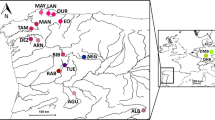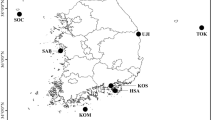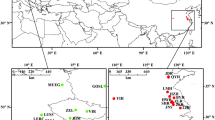Abstract
In order to test the hypothesis that natural selection can be operating on allozymes, six nuclear DNA markers were used to study population structure in six Mytilus edulis (Linnaeus, 1758) populations around the British Isles and the results compared with previous allozyme data from the same (two sites) or very close localities (the other four sites). Allozymes and nDNA markers show significant differentiation between populations at the P < 0.01 level, with the exception of the nDNA marker PLIIa. The results also indicate significant differences (modified version of the Lewontin–Krakauer test) between the two sets of markers which are about one order of magnitude higher for nDNA than for the allozyme loci. The bootstrap analysis was carried out to correct for the possibility that this difference is a sample size artefact. These results are consistent with the operation of balancing selection on allozymes or on loci in linkage disequilibrium with them.

Similar content being viewed by others
References
Allendorf, F. W. & L. W. Seeb, 2000. Concordance of genetic divergence among sockeye salmon populations at allozyme, nuclear DNA, and mitochondrial DNA markers. Evolution 54: 640–651.
Avise, J. C., 1994. Molecular Markers, Natural History and Evolution. Chapman & Hall, London.
Barker, J. S. F., S. S. Moore, D. J. S. Hetzel, D. Evans, S. G. Tan & K. Byrne, 1997. Genetic diversity of Asian water buffalo (Bubalus bubalis): microsatellite variation and a comparison with protein-coding loci. Animal Genetics 28: 103–115.
Beaumont, A. R., 1994. Linkage studies in Mytilus edulis, the mussel. Heredity 72: 557–562.
Beaumont, M. A. & R. A. Nichols, 1996. Evaluating loci for use in the genetic analysis of population structure. Proceeding of the Royal Society of London Series B 263: 1619–1626.
Begun, D. J. & C. F. Aquadro, 1993. African and North American populations of Drosophila melanogaster are very different at the DNA level. Nature 365: 548–550.
Beynon, C. M. & D. O. F. Skibinski, 1996. The evolutionary relationships between three species of mussel (Mytilus) based on anonymous DNA polymorphisms. Journal of Experimental Marine Biology and Ecology 203: 1–10.
Bierne, N., C. Daguin, F. Bonhomme, P. David & P. Borsa, 2003. Direct selection on allozymes is not required to explain heterogeneity among marker loci across a Mytilus hybrid zone. Molecular Ecology 12: 2505–2510.
Burton, R. S. & B.-N. Lee, 1994. Nuclear and mitochondrial gene genealogies and allozyme polymorphism across a major phylogeographic break in the copepod Tigriopus californicus. Proceedings of Natural Academy of Sciences United States of America 91: 5197–5201.
Clark, A. G., 1987. Neutrality tests of highly polymorphic restriction-fragment-length polymorphisms. American Journal of Human Genetics 41: 948–956.
Clark, A. G., 1990. Inference of haplotypes from PCR-amplified samples of diploid populations. Molecular Biology and Evolution 7: 111–122.
Côrte-Real, H. B. S. M., D. R. Dixon & P. W. H. Holland, 1994a. Intron-targeted PCR: a new approach to survey neutral DNA polymorphism in bivalve populations. Marine Biology 120: 407–413.
Côrte-Real, H. B. S. M., P. W. H. Holland & D. R. Dixon, 1994b. Inheritance of a nuclear DNA polymorphism assayed in a single bivalve larvae. Marine Biology 120: 415–420.
Dixon, D. R., A. M. Solé-Cava, P. L. Pascoe & P. W. H. Holland, 1995. Periostracal adventitious hairs on spat of the mussel Mytilus edulis. Journal of the Marine Biological Association of United Kingdom 75: 363–372.
Dufresne, F., E. Bourget & L. Bernatchez, 2002. Differential patterns of spatial divergence in microsatellite and allozyme alleles: further evidence for locus-specific selection in the acorn barnacle, Semibalanus balanoides? Molecular Ecology 11: 113–123.
Ewens, W. J., 1972. The sampling theory of selectively neutral alleles. Theoretical Population Biology 3: 87–112.
Excoffier, L., 1990. Evolution of human mitochondrial DNA: evidence for departure from a pure neutral model of populations at equilibrium. Journal of Molecular Evolution 30: 125–139.
Gosling, E. M., 1992. Genetics of Mytilus. In Gosling, E. M. (ed.), The Mussel Mytilus: Ecology, Physiology, Genetics and Culture. Elsevier, London. Developments in Aquaculture and Fisheries Science 25: 309–382.
Gosling, E. M., I. Astanei & A. Was, 2008. Genetic variability in Irish populations of the invasive zebra mussel, Dreissena polymorpha: discordant estimates of population differentiation from allozymes and microsatellites. Freshwater Biology 53: 1303–1315.
Heath, D. D., P. D. Rawson & T. J. Hilbish, 1995. PCR-based nuclear markers identify alien blue mussel (Mytilus spp.) genotypes on the west coast of Canada. Canadian Journal of Fisheries and Aquatic Sciences 52: 2621–2627.
Hurwood, D. A., J. M. Hughes, S. E. Bunn & C. Cleary, 2003. Population structure in the freshwater shrimp (Paratya australiensis) inferred from allozymes and mitochondrial DNA. Heredity 90: 64–70.
Inoue, K., J. H. Waite, M. Matsuoka, S. Odo & S. Harayama, 1995. Interspecific variations in adhesive protein sequences of Mytilus edulis, Mytilus galloprovincialis and Mytilus trossulus. Biological Bulletin 189: 370–375.
Karl, S. A. & J. C. Avise, 1992. Balancing selection at allozyme loci in oysters—implications from nuclear RFLPs. Science 256: 100–102.
Keith, T. P., 1983. Frequency distribution of esterase-5 alleles in two populations of Drosophila pseudoobscura. Genetics 105: 135–155.
Koehn, R. K., 1991. The genetics and taxonomy of species in the genus Mytilus. Aquaculture 94: 125–145.
Krafsur, E. S., 2002. Population structure of the tsetse fly Glossina pallidipes estimated by allozyme, microsatellite and mitochondrial gene diversities. Insects Molecular Biology 11: 37–45.
Latta, R. G. & J. B. Mitton, 1997. A comparison of population differentiation across four classes of gene marker in limber pine (Pinus flexilis James). Genetics 146: 1153–1163.
Levinton, J. S. & R. K. Koehn, 1976. Population genetics. In Bayne, B. L. (ed.), Marine Mussels: Their Ecology and Physiology. Cambridge University Press, Cambridge. International Biology Program 10: 357–384.
Lewontin, R. C., 1991. 25 years ago in genetics. Electrophoresis in the development of evolutionary genetics: milestone or millstone. Genetics 128: 657–662.
Lewontin, R. C. & J. Krakauer, 1973. Distribution of gene frequency as a test of the theory of the selective neutrality of polymorphisms. Genetics 74: 175–195.
Marchant, A. D. & D. D. Shaw, 1993. Contrasting patterns of geographic variation shown by mtDNA and karyotype organisation in two subspecies of Caledia captiva (Orthoptera). Molecular Biology and Evolution 10: 855–872.
McDonald, J. H., 1994. Detecting natural selection by comparing geographic variation in protein and DNA polymorphisms. In Golding, B. (ed.), Non-neutral Evolution: Theories and Molecular Data. Chapman & Hall, London: 88–100.
McDonald, J. H., B. C. Verrelli & L. B. Geyer, 1996. Lack of geographic variation in anonymous nuclear polymorphism in the American oyster, Crassostrea virginica. Molecular Biology and Evolution 13: 1114–1118.
Nei, M., 1987. Molecular Evolutionary Genetics. Columbia University Press, New York.
Piel, W. H. & K. J. Nutt, 2000. One species or several? Discordant patterns of geographic variation between allozymes and mtDNA sequences among spiders in the Genus Metepeira (Araneae: Araneidae). Molecular Phylogenetics and Evolution 15: 414–418.
Pogson, G. H., K. A. Mesa & R. G. Boutilier, 1995. Genetic population structure and gene flow in the Atlantic cod Gadus morhua: a comparison of allozyme and nuclear RFLP loci. Genetics 139: 375–385.
Raymond, M. & F. Rousset, 1995. GENEPOP (version 1.2): population genetics software for exact tests and ecumenicism. Journal of Heredity 86: 248–249.
Rice, W. R., 1989. Analyzing tables of statistical tests. Evolution 43: 223–225.
Riginos, C. & C. W. Cunningham, 2005. Local adaptation and species segregation in two mussel (Mytilus edulis × Mytilus trossulus) hybrid zones. Molecular Ecology 14: 381–400.
Riginos, C., K. Sukhdeo & C. W. Cunningham, 2002. Evidence for selection at multiple allozyme loci across a mussel hybrid zone. Molecular Biology and Evolution 19: 347–351.
Seed, R. & T. H. Suchanek, 1992. Population and community ecology of Mytilus. In Gosling, E. M. (ed.), The Mussel Mytilus: Ecology, Physiology, Genetics and Culture. Elsevier, London. Developments in Aquaculture and Fisheries Science 25: 87–169.
Silva, E. P., 1998. Population Genetic Studies of the Mussel Mytilus Using Nuclear DNA Markers. PhD Thesis, School of Biological Sciences, University of Wales, Swansea.
Skibinski, D. O. F., J. A. Beardmore & T. F. Cross, 1983. Aspects of the population genetics of Mytilus (Mytilidae: Mollusca) in the British Isles. Biological Journal of the Linnean Society 19: 137–183.
Stewart, F. M., 1977. Computer algorithm for obtaining a random set of allele frequencies for a locus in an equilibrium population. Genetics 86: 482–483.
Waples, R. S., 1987. A multispecies approach to the analysis of gene flow in marine shore fishes. Evolution 41: 385–400.
Ward, R. D., D. O. F. Skibinski & M. Woodwark, 1992. Protein heterozygosity, protein structure, and taxonomic differentiation. In Hecht, M. K., B. Wallace & R. J. MacIntyre (eds), Evolutionary Biology, Vol. 26. New York & London, Plenum Press: 73–159.
Watterson, G. A., 1978. The homozygosity test of neutrality. Genetics 88: 405–417.
Watterson, G. A., 1986. The homozygosity test after a change in population size. Genetics 112: 899–907.
Whittam, T. S., A. G. Clark, M. Stoneking, R. L. Cann & A. C. Wilson, 1986. Allelic variation in human mitochondrial genes based on patterns of restriction site polymorphism. Proceedings of the Natural Academy of Science United States of America 83: 9611–9615.
Acknowledgement
E.P.S. was supported by Grants from the Conselho Nacional de Pesquisas (CNPq)—Brazil and Overseas Research Students Awards Scheme (ORS/CVCP)—UK.
Author information
Authors and Affiliations
Corresponding author
Additional information
Handling editor: C. Sturmbauer
Rights and permissions
About this article
Cite this article
Silva, E.P., Skibinski, D.O.F. Allozymes and nDNA markers show different levels of population differentiation in the mussel Mytilus edulis on British coasts. Hydrobiologia 620, 25–33 (2009). https://doi.org/10.1007/s10750-008-9612-9
Received:
Revised:
Accepted:
Published:
Issue Date:
DOI: https://doi.org/10.1007/s10750-008-9612-9




